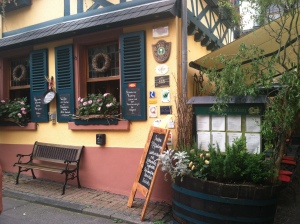Our journey started early. We arrived at our bus stop at 6:00AM and the bus left promptly at 6:30. We were on our way towards the Rhine River. Our travel bus brought us through landscape that suddenly began to burst with many cornfields, wheat fields and Riesling Grape vineyards. The countryside was lush and verdant. Interspersed through the open landscape were compact villages with red and gray roofed houses and always a church with a tall steeple.
The tour bus dropped us off in the village of St. Goar which sat right along the Rhine. From there we entered various little shops where we sampled delicious desert wines including a $495 bottle of Eiswein (Ice wine). We also tried a peach brandy that made you feel like you were lying in a peach orchard, eating peaches on a warm summer day.
Next, we trekked our way through the village square and encountered little shops selling notoriously unfashionable Cuckoo Clocks and other wooden toys—endearing as they were—but screaming with bright, obnoxiously fun colors. Window boxes hung from nearly each and every window sill and were overflowing with red and pink geraniums. We discovered quaint eateries and cozy little cafes offering apple Streusel and coffee with freshly churned cream. I noticed many of the locals were sitting outside, under umbrella covers and exchanging lively conversations.
After our village adventures, we embarked upon a Rhine River cruise ship which forged its way up the Rhine river. Many villages were situated along the Rhine and some had castles peering over the river from high up in the hills.
Our tour bus dropped us off at Reichenstein, a notable castle that was up for public tours—provided that you purchase apple cake and coffee upon your departure. We were given a walk-through tour of the castle. Afterwards we enjoyed the apple cake and coffee in the castle courtyard. From the vantage point of the highly positioned castle one could see the murky, olive green Rhine carving through the valley below. All along the sides of the river were patches of land comprised of Riesling vineyards. Many of these were on steeply slanted terrain that almost seemed to descend into the river. The German’s seemed to be adept at using every spare piece of land in a productive way.
We went into the town of Rudesheim to have a late lunch. Our lunch which was included in our tour package, consisted of jagerschnitzel with a richly delicious mushroom gravy and also French fries and salad.
I’ve noticed that restaurants in Europe typically do not serve water with the meal. In fact, you have to specifically order water and when you do, it costs money, usually between 2-3 Euros. In the U.S., I’ve taken it for granted that a glass of water is something you automatically get with your meal. Another thing that I’ve noticed about eating in German restaurants is that the portion size is not suitable for the average American glutton. For instance, a small coke is really just a small coke. I measured a scanty 6oz in my glass; it did come with a lemon slice floating on top, perhaps to compensate for its’ paucity in size.
After our meal in the little German restaurant, we ended our day by trying the famous Rudesheimer Kaffee. It is a specially made coffee made of brandy, sugar and whipped cream. They actually make it right at your table!










